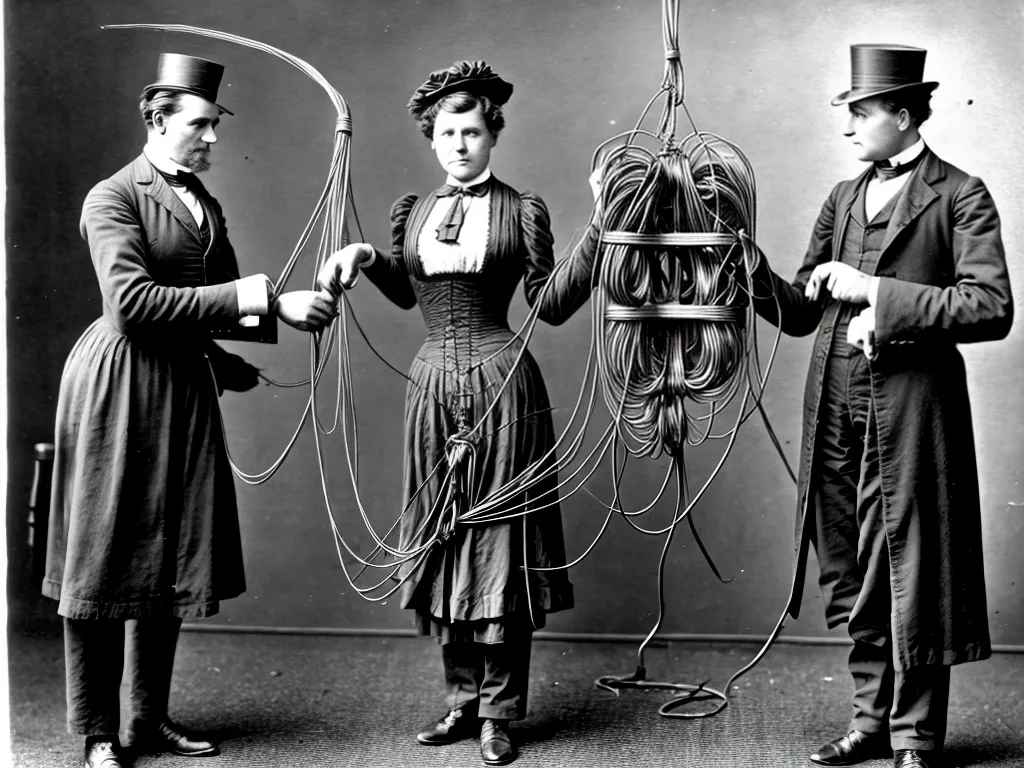
Introduction
During the Victorian era, electricians had to bundle and organize electrical wires without many of the cable management products we have today. Plastic cable ties, velcro straps, and other modern solutions were still decades away from being invented. Victorian-era electricians relied on materials they had on hand - namely, twine and string - to keep electrical wiring neat and tidy.
Twine allowed electricians to group wires together, route them properly, and protect them from damage. While crude compared to today's methods, using twine and string to bundle wires was an ingenious and practical solution during the 19th century. This article will explore how and why Victorian-era electricians used twine for bundling wires.
Twine's Advantages For Bundling Wires
Twine had several key advantages that made it the material of choice for bundling electrical wires in the Victorian period:
Versatility
Twine was inexpensive, widely available, and came in a variety of thicknesses. Electricians could select twine gauges suited to different wiring thicknesses and purposes. Thinner twine worked for low voltage wiring while thicker twine could bundle heavier cabling.
Knotting Ability
Unlike early rubber and wire insulation, twine could be tightly knotted to form secure wire bundles. Knotting allowed electricians to tightly bind wires together and attach them to surfaces. Knotted twine wouldn't slip or let wires sag.
Non-Conductive
Twine did not conduct electricity, making it safe for use around live wires. Plastic had not been invented yet, so materials like rubber and gutta-percha were used to insulate wires. Twine served as an additional non-conductive layer.
Flame Retardation
Compared to other binding options like fabric or rope, twine was less flammable. This was important since electrical fires were a risk with early wiring methods. Twine was one of the safer binding materials available at the time.
How Electricians Used Twine on Wires
Victorian-era electricians used simple but clever techniques to neatly bundle all types of electrical wiring with twine:
Cable Runs
Long cable runs were made neat by binding them at regular intervals. Electricians wrapped twine in a criss-cross pattern down the length of the cable, almost like stitching fabric. This kept the bundle tight and prevented sagging.
Branch Circuits
For wiring multiple lights or outlets from a single circuit, electricians used daisy-chain bundles. Short lengths of twine connected each wire junction. This formed a flexible chain that could be neatly routed along baseboards and ceilings.
Securing Bundles
Twine allowed wires to be securely attached along their routes. Electricians tied twine knots around hooks, beams, and other surfaces to anchor wire bundles. Proper anchoring reduced strain on the wires inside the bundle.
Organizing Wire Types
For complex installations, different twine colors helped organize different wire purposes. For example, electricians might use black twine on hot wires, white twine on neutrals, and red twine on switched hot wires. This made tracing circuits easier.
Temporary Wiring
Twine also allowed temporary orchangable wiring for early electrical experiments and prototypes. Wires could be easily re-bundled or re-routed to reconfigure circuits. The simplicity of twine bundles facilitated electrical testing.
Challenges of Using Twine on Wires
While useful, bundling wires with twine also posed some challenges for Victorian-era electricians:
Fraying Over Time
Cotton and other natural fibers frayed as twine aged. This could expose wires if the fraying was outside the bundle. Fiber deterioration also weakened bundles, causing sagging issues.
Difficult Alterations
Modifying or adding to twine-bundled wires often meant completely re-doing the bundles. Intricate knots and multiple anchor points made changes time-consuming compared to using cable ties.
Flammability
Though flame-retardant relative to other options, natural twine still posed a fire risk near electrical wires. Fiber was flammable enough that open flames had to be kept away from twine-bundled cables.
Rodent Damage
Mice, rats, and other vermin were attracted to natural fiber twine. Rodent damage could ruin wire insulation and ruin even the best-tied twine bundles.
The End of Twine-Bundled Wires
The use of twine for bundling wires declined in the early 20th century. Several factors led to twine being replaced by newer, better materials:
-
Plastics like vinyl allowed insulated, non-flammable wire jackets. Wires no longer needed additional protection from contact and fire.
-
Metal and plastic wire conduits emerged as the preferred wire routing method. Conduit eliminated the need for exterior wire bundling.
-
Plastic cable ties were invented in the late 1950s. Nylon ties quickly became the standard thanks to their convenience.
-
Electrical codes evolved to require safer, long-lasting wire installation methods without natural fiber materials.
Today, plastic cable ties and velcro-style wraps are predominant. But for a creative period of electrical innovation, Victorian-era electricians relied on the simple natural technology of twine and string to organize their revolutionary wire networks. The twine wire bundle served wiring needs for decades until electrical and material science advanced.